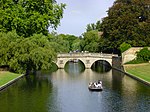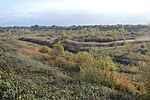River Granta

The River Granta is the name of two of the four tributaries of the River Cam, although both names are often used synonymously. The Granta starts near the village of Widdington in Essex, flowing north past Audley End House to merge with the other contributary Rhee, which is also commonly called River Cam, a mile south of Grantchester. From source to its confluence with the Rhee it is 41.7 kilometres (25.9 mi) in length. A further tributary, also known as the Granta, runs 10 mi (16 km) from south of Haverhill to join the larger Granta south of Great Shelford. Another minor tributary is Bourn Brook which has its source near the village of Eltisley, 10 mi (16 km) west of Cambridge, running east through Caxton, Bourn and Toft to join the Cam at Byron's Pool. In many maps the river changes its name at the Silver Street Bridge in Cambridge and is called "Granta" above and "Cam" below it.In earlier times even the lower part of the Cam was also named the Granta, but after the name of the Anglo-Saxon town of Grantebrycge had been modified to Cambridge, the river was renamed to match. Grantchester and Granta Park are on the river banks of the river Granta and their names refer to the river itself.
Excerpt from the Wikipedia article River Granta (License: CC BY-SA 3.0, Authors, Images).River Granta
Cross Bank Drove, East Cambridgeshire
Geographical coordinates (GPS) Address Nearby Places Show on map
Geographical coordinates (GPS)
| Latitude | Longitude |
|---|---|
| N 52.35 ° | E 0.26666666666667 ° |
Address
Cross Bank Drove
Cross Bank Drove
CB6 3HR East Cambridgeshire
England, United Kingdom
Open on Google Maps










